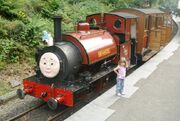| Sir Handel | |
|---|---|
 | |
| Vital statistics | |
| Title | Sir |
| Gender | Male |
| Status | Operational |
| Location | Skarloey Railway |
Sir Handel is a fictional steam locomotive from The Railway Series children's books by the Rev. W. Awdry. He lives and works on the Skarloey Railway on the Island of Sodor as Engine No.3, and is named after the owner of the railway, Sir Handel Brown.
Railway Series history[]
Sir Handel was originally called Falcon and worked on the Mid Sodor Railway with his mentor Duke and younger partner Stuart. According to Wilbert Awdry's notes, Falcon was built by the Falcon Engine & Car Works in Loughborough in 1904 to replace a scrapped engine; he arrived as a 0-4-0 without trailing wheels, which caused him to ride roughly. He was sent back accordingly in 1910 to be modified.
There is some scrutiny though, as Falcon's factual counterparts, according to legit sources, were rebuilt with trailing wheels prior to 1900, so surely the builders would have already been aware of the issues presented. Recent findings on Sodor confirmed Falcon was in service for longer than stated, and 1904 was when he returned to his builders for a rebuild. Prior to this, Falcon learnt to respect Duke when they double-headed a train together on the Mountain Road, resulting in him almost becoming a cropper. He remained steadfast however in his anchored belief that he was meant to pull passengers in smooth-riding bogie coaches.
Falcon remained on the Mid Sodor until it finally closed in 1947. He and Stuart were then bought to assist in an expansion scheme for the Sodor Aluminium Company just north of Peel Godred. After the job was finished, they were bought by the Skarloey Railway at knockdown prices in 1951, entering service the following year. During preliminary repairs, it was found Falcon's frames dated from 1904. Gaining his present name, Sir Handel had problems with staying on the track, sometimes slipping between the rails deliberately, so in 1960, he was fitted with a set of wheels with widened tyres, nicknamed "steamroller wheels" by the other engines. This led into his immortalised encounter with George the Steamroller, which did not come out lightly for him when he was ridiculed by a group of boys after thinking he won the day.
In the 1980s, following major repairs (during which he received a modified cab), he was sent to the Talyllyn Railway in Wales when one of their engines needed repairs. More recently, he deliberately allowed his fire-bars to collapse in retaliation to Peter Sam getting a rest following his visit to Wales. He owned up when he thought he wasn't being prioritised, although it was secretly because the replacement fire-bars for him took a while to be delivered.
Prototype[]

Talyllyn No. 3 in the guise of Sir Handel at Tywyn Wharf
Sir Handel is based on the locomotive Sir Haydn which works at the Talyllyn Railway in Gwynedd, Wales. This locomotive was built by Henry Hughes & Co at the Falcon Works in Loughborough in 1878, one of three identical locomotives for the 2-foot 3-inch gauge Corris Railway in Merionethshire. Nos. 1 and 2 were scrapped in 1930 and No.3 worked until the Corris Railway closed in 1948, hauling the last train on 20 August that year.
After three years covered by a tarpaulin at Machynlleth Station No. 3 was purchased for £25 (and named) by the nearby Talyllyn Railway in 1951. The original cab was replaced in the 1960s, and this change can be seen in the TV version of Sir Handel. Sir Haydn the real locomotive is named after Sir Henry Haydn Jones former owner of the Talyllyn Railway and the person upon whom the owner of the Skarloey railway is based. The Corris Railway is currently building a new locomotive to the same design.
In the 1980s, the Talyllyn Railway repainted Sir Haydn to represent Sir Handel. Christopher Awdry wrote this into the 1985 book Great Little Engines, explaining that Sir Handel was visiting the line to help out. An incident in which Sir Haydn ran into a tree branch and was given a bandage and eyepatch was turned into a story in the book, with almost no alteration from the real event.